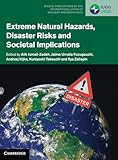Extreme natural hazards, disaster risks and societal implications / edited by Alik Ismail-Zadeh and # others.
Material type: TextSeries: Special publications of the international union of geodesy and geophysicsPublication details: Cambridge Cambridge University Press 2014Description: xi, 402 pages :billustrations (some colored)ISBN:
TextSeries: Special publications of the international union of geodesy and geophysicsPublication details: Cambridge Cambridge University Press 2014Description: xi, 402 pages :billustrations (some colored)ISBN: - 9781107033863 (hardback)
- 363.34 ISM.E
| Item type | Current library | Home library | Call number | Status | Date due | Barcode | |
|---|---|---|---|---|---|---|---|
 Book
Book
|
Dept. of Geology Processing Center | Dept. of Geology | 363.34 ISM.E (Browse shelf(Opens below)) | Available | GEO4450 |
Browsing Dept. of Geology shelves, Shelving location: Processing Center Close shelf browser (Hides shelf browser)
Includes bibliographical references and index.
Machine generated contents note: Preface; Acknowledgments; List of contributors; Part I. Introduction: 1. Extreme natural hazards and societal implications - ENHANS project Alik Ismail-Zadeh; 2. The grand challenges of integrated research on disaster risk Gordon McBean; Part II. Extreme Hazards and Disaster Risks: 3. Extreme volcanism: disaster risks and societal implications Amy Donovan and Clive Oppenheimer; 4. Extreme seismic events: from basic science to disaster risk mitigation Alik Ismail-Zadeh; 5. The spatial-temporal dimensions of landslide disasters Irasema Alctara-Ayala; 6. Global climate model and projected hydro-meteorological extremes in the future Akio Kitoh; 7. Physically-based hurricane risk analysis Ning Lin, Kerry Emanuel and Erik Vanmarcke; 8. Satellite-based remote sensing estimation of precipitation for early warning systems Soroosh Sorooshian, Phu Nguyen, Scott Sellars, Dan Braithwaite, Amir AghaKouchak and Kuolin Hsu; 9. Predicting and mitigating socio-economic impacts of extreme space weather: benefits of improved forecasts Daniel N. Baker, Jamie M. Jackson and Lauren K. Thompson; 10. Predictability of extreme events in a branching diffusion model Andrei Gabrielov, Vladimir Keilis-Borok, Sayaka Olsen and Ilya Zaliapin; Part III. Case Studies: Latin America and the Caribbean Region: 11. Earthquakes, tsunamis, and the related vulnerability in South America and the Caribbean - an overview Omar J. Pe;rez, Carlos Rodri;guez and Jose; L. Alonso; 12. Magnetic studies of active volcanoes in Mexico: implications for volcanic hazards and volcano monitoring Jaime Urrutia-Fucugauchi; Part IV. Case Studies: Africa: 13. Volcanism in Africa: geological perspectives, hazards and societal implications Nils Lenhardt and Clive Oppenheimer; 14. Recent volcanic eruptions in the Afar rift, north-eastern Africa, and implications for volcanic risk management in the region Gezahegn Yirgu, David J. Ferguson, Talfan D. Barnie and Clive Oppenheimer; 15. Large recorded earthquakes in Sub-Saharan Africa Vunganai Midzi and Brassnavy Manzunzu; 16. Tsunami impact on the African continent: historical cases and hazard evaluation Vyacheslav K. Gusiakov; 17. Advancing disaster risk governance in Madagascar: the role of higher education institutions Mahefasoa T. Randrianalijaona and Ailsa Holloway; Part V. Case Studies: Middle East: 18. Natural hazards in Saudi Arabia Abdulaziz M. Al-Bassam, Faisal K. Zaidi and Mohammad T. Hussein; 19. Large earthquakes and tsunamis in the Mediterranean region and its connected seas Gerassimos A. Papadopoulos and Antonia Papageorgiou; 20. Earthquake risk and risk reduction capacity building in Iran Mohsen Ghafory-Ashtiany; Part VI. Case Studies: Asia and the Pacific Region: 21. The Chao Phraya floods 2011 Sucharit Koontanakulvong; 22. Environmental risk management in Australia: natural hazards Tom Beer; 23. The 2008 Wenchuan, China, earthquake Zhongliang Wu and Tengfei Ma; 24. The 2011 Tohoku, Japan, earthquake and tsunami Kenji Satake; 25. India's tsunami warning system T. Srinivasa Kumar, Shailesh Nayak and Harsh K. Gupta; Part VII. Disaster Risks and Societal Implications: 26. The International Strategy for Disaster Reduction and the Hyogo Framework for Action (2005-15): essential tools for meeting the challenges of extreme events Sálvano Briceño; 27. Disaster policy and climate change: how much more of the same? Stephen Dovers and John Handmer; 28. Vulnerability, impacts and adaptation to sea level related hazards taking an ecosystem based approach Keith Alverson; 29. Extreme geohazards: risk management from a (re)insurance perspective Anselm Smolka; 30. Hitting the poor: public-private partnership as an option. Impact of natural catastrophes on economies at various stages of development Angelika Wirtz, Petra Löw, Thomas Mahl and Sibel Yildirim; Index.
"This book presents a unique, interdisciplinary approach to disaster risk research, combining cutting-edge natural science and social science methodologies. Bringing together leading scientists, policy makers and practitioners from around the world, it presents the risks of global hazards such as volcanoes, seismic events, landslides, hurricanes, precipitation floods and space weather, and provides real-world hazard case studies from Latin America, the Caribbean, Africa, the Middle East, Asia and the Pacific region. Avoiding complex mathematics, the authors provide insight into topics such as the vulnerability of society, disaster risk reduction policy, relations between disaster policy and climate change, adaptation to hazards, and (re)insurance approaches to extreme events. This is a key resource for academic researchers and graduate students in a wide range of disciplines linked to hazard and risk studies, including geophysics, volcanology, hydrology, atmospheric science, geomorphology, oceanography and remote sensing, and for professionals and policy makers working in disaster prevention and mitigation"--
There are no comments on this title.







